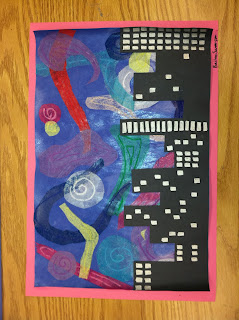This week, we completed a Hidden Safari project. Materials for this project included materials to make red glasses (which work to see the blue colored pencil), a white sheet of paper for each student, a light blue colored pencil for each student and templates for drawing animals for the students to use as resources. The students will also need their crayons for this project. Before even beginning the project, each student in the class made their own hidden safari glasses. These were made out of a red translucent material and red construction paper. The teacher handed out a template and walked the students through making the glasses. Once the glasses were finished, the next thing we did was practice drawing animals. We were told to draw the animal upside down in order to worry less about what the animal looks like and more about the lines it was made up of. After we felt confident drawing an animal, we were told to draw an animal on our white sheet of paper using the blue colored pencil. We drew the animal upside down just like we practiced. We were able to draw any animal that we liked, but more specifically an animal that you would see on a safari. After we were finished drawing our animals, we were supposed to hide or camouflage our animal using warm colors. We discussed that warm colors are red, yellow and orange. We learned that the best way to hide our safari animals was to use layers of patterns in order to distract the eye away from the blue. We were then told to talk to our neighbors while putting on our glasses and seeing if we could guess what the hidden safari animal was. Once we felt that the animal was hidden well enough, we put a sheet of construction paper on the back as a border and made sure we signed our name.
An extension activity that a teacher could do with this project is to take their students on a virtual safari. The teacher could find pictures and videos of actual safari animals and then show them to their students. The students would check out the safari animals and when the virtual safari was finished, they would fill out a worksheet on the different animals that they saw. This could correspond with a science lesson on different kinds of animals and if they are mammals, amphibians, reptiles, or other types of animals. It would be fun and would help the students classify animals into their groups.



